
It may not be worthy of Agatha Christie or Sherlock Holmes, but the case of the missing corn acres is a mystery that rattled the market in the wake of USDA’s Aug. 12 reports. Unlike fictional detective stories, this is one puzzle that may never be solved.
USDA’s National Agricultural Statistics service shocked the market by reporting corn plantings at 90 million acres, nearly a million more than last year. But at the same time another wing of USDA, its Farm Service Agency, reported farmers filled prevent plant corn claims of 11.2 million acres.
The two numbers didn’t seem to jibe unless farmers were hoping to plant a record 101.2 million acres of corn this spring. That could be the case, though it seems highly unlikely. Previous surveys by NASS, as well as four Farm Futures surveys over the past year found nowhere near that level of interest in corn.
Surveys use a sample of a population, in this case farmers, to make a projection of what all growers did. This invariably injects sampling error into the equation, though both the NASS and Farm Futures surveys miss the mark by 2% to 3%.
The FSA data is different and that’s what makes it unique. It’s not a sample. Rather, it’s the complete population of farmers certifying acreage to the agency. Not all farmers do this, but most do historically, especially in a year like 2019, when filing the reports was mandatory to collect Market Facilitation Program payments. The FSA begins reporting data in August; not all claims are in right away and some county offices may be slow to report. But the August acreage certifications and prevent plant claims provide a good overview of what might happen with final acreage reports.
This year, for example, there was a very strong correlation between prevent plant claims and changes in acreage for major crops – except for corn. The more acres of prevent plant, the more acreage for these crops was likely to be down.
Corn was the outlier. With such a large prevent plant total, acreage should have been lower too. That’s what our Farm Futures August production survey found. Farmers said they were prevented from planting an estimated 12.3 million bushels – more than FSA, but in the ballpark. But our farmers also said they planted 5.9 million less than last year, and 8.2 million less than NASS’s June survey found.
NASS resurveyed growers who were still planting in June for its August update. So some of that ground didn’t get planted to corn. But there’s a big difference between 1.7 million acres lost from June to August and the 11.2 million of prevent plant FSA reported.
The numbers for soybeans were much more in synch. NASS in August reported 3.34 million fewer soybean acres than it found in June. FSA reported farmers had filled prevent plant claims for beans of 4.35 million.
August prevent plant claims in the past for corn offered clues about what NASS would report later in the fall and winter for acreage. The higher the prevent plant claims, the more likely NASS was to lower its estimates of both planted and harvested acreage later. Based on this pattern the 11.2 million prevent plant claimed in August translates into a loss of 5.4 million planted acres and 3.7 million harvested acres. That would take planted acreage down to 84.6 million, with harvested falling to 78.3 million.
It’s virtually impossible the planted tally would budge that much because FSA in August said farmers certified 85.8 million acres. Acreage reported by FSA and NASS is never the same but the two track each other. This suggests NASS’s 90 million could be close, unless a higher of farmers filled this year to obtain MFPs.
Harvested acreage could conceivably fall significantly from NASS’s August estimate. Some years with late planting also saw spikes in PP claims compared to the previous year. Late-planted fields are more likely to be cut for sileage if the crops didn’t develop enough to make grain by the time the first killing frost hit.
There’s another possible solution to the mystery. Some farmers may have initially filed for prevent plant corn then decided to forgo the payment and put in soybeans or another crop instead. Others may have been able to switch intended acres last minute to corn by buying seed and fertilizer, then filed prevent plant, returning the seed and keeping the fertilizer for fall or planting the corn as their cover crop. Acreage limitations on prevent plant, not to mention logistics, would seem to make these long shots at best for explaining what happened.
So, there are clues to the great corn acreage mystery. But so far, no smoking gun.
About the Author(s)
You May Also Like






